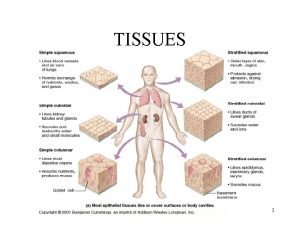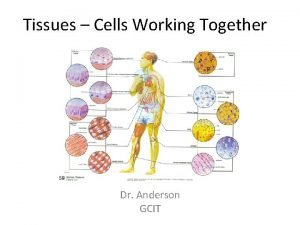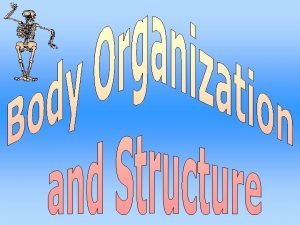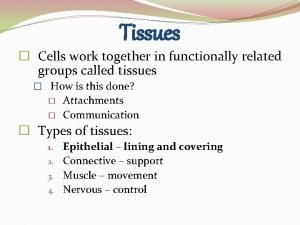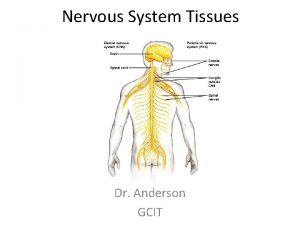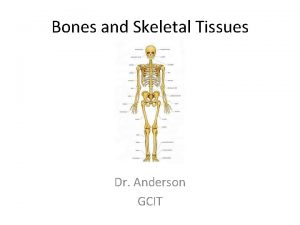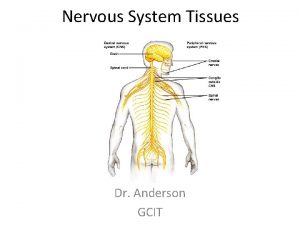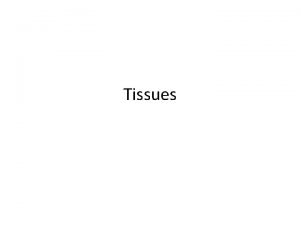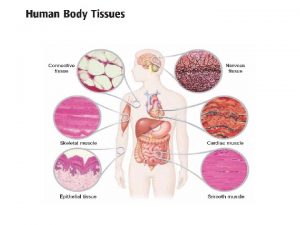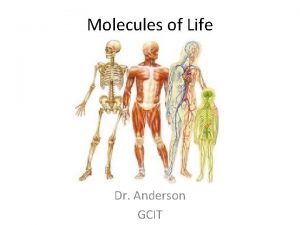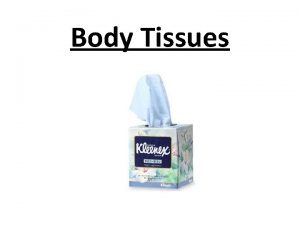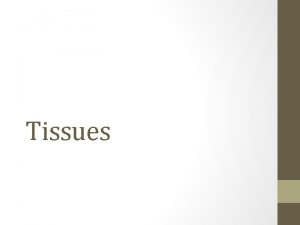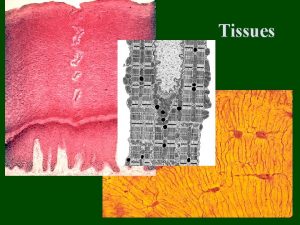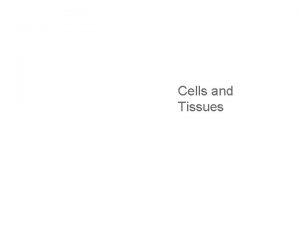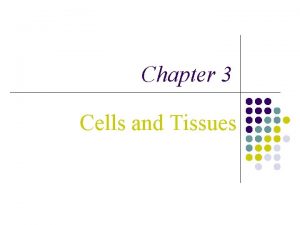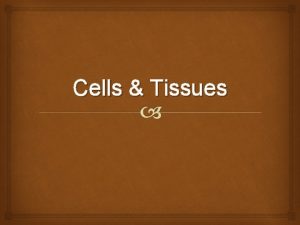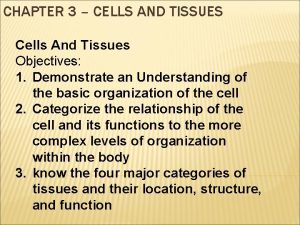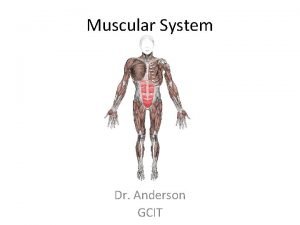Tissues Cells Working Together Dr Anderson GCIT Tissues






































- Slides: 38

Tissues – Cells Working Together Dr. Anderson GCIT

Tissues • Collections of similar cells that work together in an organ to perform a very specific function in that organ for the organism • Four basic tissue types – Epithelial – Connective – Movement – Control

Epithelial Tissue • Sheets of cells that cover the body or line body cavities – Covering – lining epithelium • Skin • Lines open cavities of digestive, respiratory, cardiovascular and reproductive systems – Glandular epithelium • Makes up the various glands (secretory organs) of the body

Functions of Epithelia • Protection – Protects stomach from digesting itself by secreting buffering compounds • Absorption – Cells can take in substances via endocytosis/diffusion/active transport • Filtration – Certain substances are preferentially removed/added to blood • Excretion – Wastes exit via exocytosis, diffusion • Secretion – Cells products (proteins) are exported via exocytosis, diffusion • Sensory Perception – Cells on the surface contain nerve endings that respond to stimulus (heat, pain, pressure, etc. )

Characteristics of Epithelia • Polarity – All epithelial cells have two distinct “ends” • Apical Surface – free surface exposed to exterior or lumen of a body cavity • Basal Surface – bordered by the basal lamina, a non-cellular adhesive sheet to which epithelial cells are attached that acts as a filter between the epithelia and underlying connective tissue

Polarity of Epithelial Cells Apical surface Basal lamina

Epithelial Connections • Tight Junctions – Prevent the movement of materials between cells • Desmosomes – Provide support and tensile strength to tissues

Epithelial Support • All epithelial cells are supported by a thin layer of connective tissue called the reticular lamina (just deep to the basal lamina) • The basal lamina and the reticular lamina form the basement membrane

Communication and Transport • Epithelial cells are innervated (nerves penetrate into the tissue) • However, epithelial cells are NOT perfused directly with blood vessels – Materials must be transported to and from blood in vessels lying under the basement membrane

Epithelial Cell Arrangement

Epithelial Regeneration • Cells are frequently lost due to abrasion, wounds, etc. • Epithelial cells have the capacity to regenerate the lost tissue via mitosis • How is this adaptive to the organism?

Classification of Epithelia • Morphology – Squamous – Cuboidal – Columnar • Arrangement – Simple – Stratified

Epithelial Morphology • Squamous – flat, much shorter than wide • Cuboidal – height and width are equidistant • Columnar – Height much greater than width

Simple Epithelium

Stratified Epithelium • Contain two or more cell layers • Major role: Protection • E. G - skin

Glandular Epithelia • Tissues that secrete substances (usually proteins) made by the cells in the tissue • Endocrine glands – no ducts – Produce hormones, proteins, steroids, etc. • Exocrine Glands – secrete onto body surfaces or into cavities – Mucus, sweat, oil, pancreas, salivary,

Endocrine Glands

Exocrine Glands • Unicellular – mucus glands and goblet cells • Multicellular - 3 parts – Duct - for export – Secretory unit – makes product to be secreted – Fibrous capsule – connective tissue, blood vessels and nerves; may divide the gland into lobes

Mode of Secretion • Cells metabolize the chemical to be released • Cells release this chemical into the duct via exocytosis (or cell lysis)

Tubular – if secretory cells are present in the duct Alveolar – if secretory cells are in the pocket of tissue

Connective Tissue • Function 1. 2. 3. 4. Binding and support (Bone, cartilage, fascia) Protection – Osteocytes (Bone) Insulation – Adipose Tissue (fat) Transportation ( Blood)

Common Characteristics • Common embryologic origin (mesenchyme) • Degrees of vascularity • Consists of living cells and an extracellular matrix – Non-living cell-derived substances – Made of ground substance and fibers

Ground Substance • Made of interstitial fluid, cell adhesion proteins, proteoglycans • Can range from very little to great viscosity – Serves to control diffusion rates into and out of adjoining cells (between blood vessels and epithelium)

Fibers • Collagen – provide tensile strength • Elastic Fibers - (elastin) can stretch, allowing flexibility • Reticular Fibers – collagen -based fibers that support small blood vessels and organs

Cells • Relative to what organ is being examined, each has a different job • Osteocytes • Chondrocyte • Hemocyte

Types of Connective Tissue • Loose Connective Tissue – Areolar – Adipose • Dense Connective Tissue – Regular – Irregular – Elastic

Areolar Connective Tissue • Very loosely arranged fibers in matrix – Provides a reservoir for water and salts for surrounding tissues – Very viscous – Damage to this area or nearby tissues results in water retention – an edema

Adipose Connective Tissue • Fat tissue – composed of adipocytes • Almost the entire volume of the cell is taken up by stored lipids • Stores energy, but subcutaneous fat (under the skin) acts as a – Shock absorber – Insulator

Dense Regular Connective Tissue • Contains closely packed collagen fibers that run parallel to the direction of pull providing great tensile strength – Fibroblasts are interspersed within this tissue to make new collagen fibers • Found in: – Tendons – connect muscle to bone – Aponeuroses – connect muscles to muscles – Fascia – covering that surrounds individual muscles

Dense Irregular Connective Tissue • Also contains bundles of collagen fibers, but are arranged irregularly • Forms fibrous coverings (capsules) that surround some organs and joints, e. g. kidneys, bones, cartilage, etc.

Cartilage • Combines flexibility and strength for support and shock absorption • Not vascular and not innervated • Hyline cartilage • Elastic Cartilage • Fibrous Cartilage

Hyaline Cartilage • Hyaline (glassy) cartilage – Provides firm support to the ends of long bones (cushioning) – Connects bones and provides structure • Bridge of nose • Connects ribs to sternum • Predecessor to bone in human embryos

Elastic Cartilage • More flexible and less rigid than hyaline cartilage • Examples – Ear – Epiglottis

Fibrocartilage • Able to resist heavy compressive forces in areas of the body under the most strain – Cartilage between the femur and tibia/fibula in the knee – Intervertebral discs

Bone • Primarily provides support to the body, but also houses tissues that produce fat and blood cells (marrow) • Bone is well supplied by blood vessels (bones are living tissue) • Great diversity of shapes and functions

Blood • Blood cells (WBC, RBC, platelets) surrounded by a liquid matrix (plasma) • Transports materials to all of the cells in the body – O 2, CO 2, food, wastes, hormones, etc. • Provides the second line of defense against pathogens

Nervous Tissue • Comprises the brain, spinal cord, and peripheral nerves • Major cell type – Neurons – respond to stimuli and transmit impulses

Muscle Tissue • Responsible for most types of movement – Internal movement as well as external • Three types – Skeletal – under voluntary control, moves skeleton – Smooth – under involuntary control, moves substances into, out of, or through the body – Cardiac – heart muscle, under involuntary control (largely)
 Tissues are groups of similar cells working together to
Tissues are groups of similar cells working together to Tissues are groups of similar cells working together to
Tissues are groups of similar cells working together to Tissues are groups of similar cells working together to:
Tissues are groups of similar cells working together to: Body tissues chapter 3 cells and tissues
Body tissues chapter 3 cells and tissues Body tissues chapter 3 cells and tissues
Body tissues chapter 3 cells and tissues Cells form tissues. tissues form __________.
Cells form tissues. tissues form __________. Body tissues chapter 3 cells and tissues
Body tissues chapter 3 cells and tissues Chapter 3 cells and tissues
Chapter 3 cells and tissues Tissues working together
Tissues working together Similar cells working together
Similar cells working together Group of cells working together
Group of cells working together Division of anatomy
Division of anatomy Chapter 3 cells and tissues figure 3-7
Chapter 3 cells and tissues figure 3-7 Chapter 3 cells and tissues figure 3-7
Chapter 3 cells and tissues figure 3-7 What is the function of the golgi apparatus
What is the function of the golgi apparatus Cells group together to form
Cells group together to form Haploid vs diploid venn diagram
Haploid vs diploid venn diagram Plant and animal cells venn diagram
Plant and animal cells venn diagram Olfactory groove keros classification
Olfactory groove keros classification Younger cells cuboidal older cells flattened
Younger cells cuboidal older cells flattened Nondisjunction in meiosis
Nondisjunction in meiosis Somatic cells vs germ cells
Somatic cells vs germ cells Prokaryotic cell
Prokaryotic cell Principal cells vs intercalated cells
Principal cells vs intercalated cells 4 types of eukaryotic cells
4 types of eukaryotic cells Cell substance
Cell substance Red blood cells and white blood cells difference
Red blood cells and white blood cells difference The organelle trail
The organelle trail Thyroid gland
Thyroid gland Is a staphylococcus cell prokaryotic or eukaryotic
Is a staphylococcus cell prokaryotic or eukaryotic Prokaryotic cell vs eukaryotic
Prokaryotic cell vs eukaryotic Masses of cells form and steal nutrients from healthy cells
Masses of cells form and steal nutrients from healthy cells Hot principle
Hot principle Hot working and cold working difference
Hot working and cold working difference Differentiate between hot working and cold working
Differentiate between hot working and cold working Hard work vs smart work presentation
Hard work vs smart work presentation Prinsip dasar proses pengerjaan panas yang benar adalah
Prinsip dasar proses pengerjaan panas yang benar adalah Working together works
Working together works Words of wisdom about working together
Words of wisdom about working together

